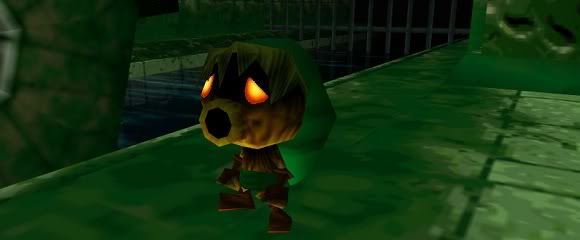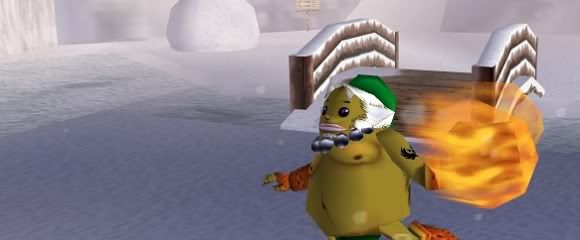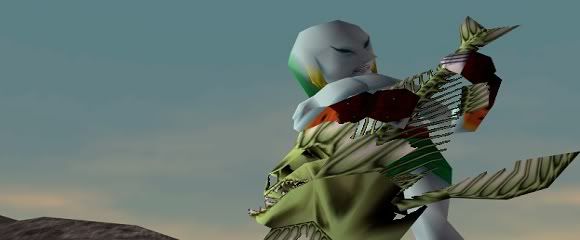
I never finished Majora's Mask. The farthest I ever got was the end of Great Bay Temple, five or six years ago, where I was mercilessly slaughtered by Gyorg and could never muster up the will to go all the way through the dungeon again.
Recently, I played through all of Ocarina of Time in one eleven-hour sitting. I didn't use any guides, and I didn't 100% the game, though I did get a good amount of heart pieces (probably 20+) and 50+ gold skulltulas (which is all you need as far as rewards go -- you just get infinite rupees for getting all 100). There was, of course, no way I was going through all the effort of getting the Ice Arrows, seeing as they're utterly useless. Still, I got all the important things (sans the Biggoron Sword), and I even reflected Ganondorf's energy blasts with an empty bottle for laughs.
When I was done, I wanted to play Majora's Mask. So, after a lengthy and satisfying sleep, that's what I did. I wanted to play it on my N64, but when I turned the game on and started playing, it was, well... really ugly. Emulated, it looks pretty nice due to all the texture upscaling, filtering and anti-aliasing. That way I could also use save states to overcome the game's dreadful save system, because I'm all for utilizing technology to subvert bad game design.
You've probably read a lot of blog entries online about the artistic merit buried in Majora's Mask, and I definitely agree with those sentiments. It's a beautifully dark, abstract and surprisingly grotesque game, filled with all kinds of bleak imagery and general melancholy. The game revolves around the concept of having three days to stop the moon from falling and subsequently destroying the world, giving you a constant sense of urgency even though, in reality, you have plenty of time, assuming you use the Inverted Song of Time. Before those three days are up, of course, you can play the Song of Time to reset everything and start again from the first day, keeping any important key items you may have gained from completing dungeons and other side quests. I started to notice a lot of parallels with Chrono Cross as I played, actually -- they're both sequels to beloved games that depart quite drastically from their established formulas, and both feature a much darker tone than their predecessors.
One thing I picked up on the first time I played the game was the fact that, after completing a dungeon, the surrounding area is released from its darkly cursed state, changing the music back to the standard Termina Field music rather than the dreary, plodding melody that lingers beforehand. Then, since unless you're a skilled speedrunner, you can't finish all the dungeons in one three-day cycle, you reset time and everything is back to being depressing. It adds a sense that you're not making any real progress until you stop that moon, and it's always there, staring into your soul.

There's also the constant theme of masks running through the heart of the narrative: "mask" is in the title, after all. The three transformational masks which turn Link into a Deku, Goron or Zora are obtained by "healing" dying warriors of their respective races with the Song of Healing. They then retreat peacefully to the after life after a very interesting and somehow touching scene involving the warrior being sent off by his brethren. The whole process is actually quite beautiful with the combined imagery and music. When Link actually dons said masks to transform, you see him scream in pain as his body contorts into its new shape -- a constrastingly haunting image.
The overall mood of the game can be describe as nothing short of bizarre, with one of the stranger highlights being someone's long, pale arm poking out of a toilet asking you for paper -- in a humorous turn of events, you oblige him by handing him a title deed.
There's definitely something esoteric running through the entirety of the game's design, from its narrative to its structure to its level design. The dungeons of Majora's Mask are the most difficult in the entire series, though there's only really four of them -- and I'm not sure if it's because they're cleverly or badly designed. Probably a bit of both. Snowhead Temple in particular has a massive room in the middle that spans every floor of the dungeon, and if you're at the top and you fall down, you basically have to go through the entire dungeon over again. That is terrible. The thing is, that can very easily happen, with sections that require you to roll along the walls as Goron Link. Great Bay Temple is extremely confusing, as anything that deals with the flow of water usually is. Stone Tower Temple involves flipping the entire dungeon upside down repeatedly, so that by itself gives you an idea of how complex it is -- in short, Majora's dungeons, much like the rest of the game, are intimidating.
The game is, as a whole, obtusely designed; it's not just the dungeons. Several of the quests have unclear objectives and, due to the game's time-sensitive nature, are extremely time-consuming to retry if you fail (case in point: the entire Romani Ranch quest). Since things happen on specific schedules, you often find yourself just waiting around for extended periods of time -- you can advance time instantly by playing the Song of Double Time, but it only advances you to the next day transition -- that is, either 6 AM or 6 PM, and most time-sensitive events are at awkward hours like midnight or 1 AM. If you plan to 100% the game, you're forced to do several of the game's quests more than once, even one that spans an entire cycle and requires very precise timing, twice.

This brings us back to the save system, which is functionally broken and completely unhelpful. Here's how it works: The only time you can save the game is when you reset the three-day cycle with the Song of Time. Alternatively, you can do a sort of "quick save" at one of the owl statues, but that forces you to quit the game, and you can only load it once before it's automatically deleted. Sound terrible? Now imagine you just waited about 10 minutes between 6 PM and 1 AM for the Romani Ranch alien invasion event. The aliens reach the barn and you fail. Your first instinct? "Reload and try again," right? But you can't. You have to reset the cycle, go buy another powder keg for 100 rupees, blow up the rock on Milk Road, talk to Romani, wait around for a while, then you can try again.
To be honest, it's not a very good game. It's designed in a way that frustrates easily because it's difficult for the wrong reasons, like several small design missteps that quickly snowball and clumsy dungeon design. The save system, of course, and so many reused characters from Ocarina of Time that look exactly the same as before but are apparently different people -- something that is never explained. It's perplexing, though, because to say it favors style over substance isn't correct. The story and atmosphere actually have substance, more than most games, in fact. The structure of the levels in general is lazy and frustrating, but the controls themselves have been improved from Ocarina of Time, and the various masks add a lot of gameplay variety. Every time I think about playing the game, I get a sinking feeling because everything about it is so obnoxious, but when I think about the plot and atmosphere, it makes me wish the game itself was a lot better.
My current file sits me at the start of Stone Tower Temple, and I don't want to continue. The game has burned me out after wading through countless obnoxious fetch quests and inconveniently designed objectives, and I just can't take it anymore. Getting the Mirror Shield was one of the most annoying things I've ever had to do in a Zelda game, and I can't imagine how awful the Zora Egg quest would have been if I didn't have five bottles.
Don't listen to the hipster kids who say "Majora's Mask is the best Zelda cuz it's art, bro," because games aren't supposed to be measured on their aesthetic alone, and Majora's Mask is fundamentally broken in other, more important aspects. That's not to say it isn't worth playing, because it definitely is. It's not as replayable as Ocarina of Time because as a game, it's not as good, and it's not paced nearly as well. In fact, the pacing is one of those broken aspects, possibly intentionally so. However, as an overall experience, it's something you should play at least once if you're a fan of Zelda, or a fan of games with a unique aesthetic that actually feels meaningful and genuine.

I suppose Majora's Mask was an interesting experiment in focusing on the development of character's personalities and fleshing out the world of Termina, as most of the side quests involve helping people with personal issues and learning about their backstories. Termina is a bit smaller than Ocarina's Hyrule, so it's a more compact world with more detail. It was good they tried it once, but I'm glad it didn't become a trend. Wind Waker tried new things in its own way, and Twilight Princess revisited the old Link to the Past/Ocarina of Time formula with mixed results.
It's been rumored that the next Wii Zelda is taking a lot of inspiration from Majora's Mask, and I really hope it's not in the form of a time limit or annoying scheduled events -- on the other hand, it'd be a great idea to expand on that aesthetic style. On the other other hand, I find Zelda is at its best when it's experimenting and trying new things, even if it's not always successful. Twilight Princess was good, but it was a bit too familiar, so it felt like it was missing something. Ocarina of Time was so great because it took A Link to the Past's structure and brought it into a new dimension. Since they haven't invented 4D gaming yet, it's time to develop something new and innovative, and I think they'll find a way. That's how Nintendo rolls.


No comments:
Post a Comment